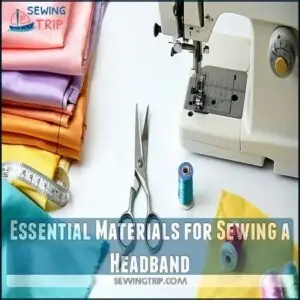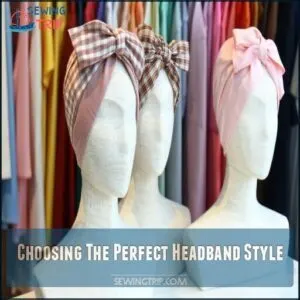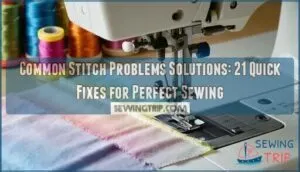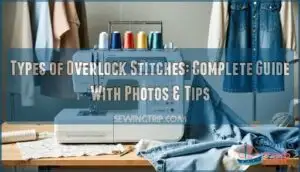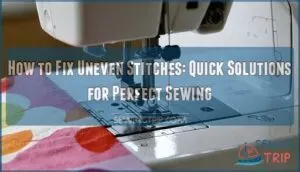This site is supported by our readers. We may earn a commission, at no cost to you, if you purchase through links.
 Sewing a headband is easier than you’d think, and it’s a great way to show off your style!
Sewing a headband is easier than you’d think, and it’s a great way to show off your style!
Start with soft, stretchy fabric like jersey or cotton.
Measure your head and cut the fabric to the right length (a little shorter for stretchiness).
Fold it lengthwise, right sides together, and sew along the edge to make a tube.
Turn it inside out, stitch the ends together, and voilà!
A custom headband is born.
Experiment with twists, bows, or even some sparkly embellishments.
Trust me, once you make one, you’ll want to sew a whole army of headbands.
Let’s get creative!
Table Of Contents
- Key Takeaways
- Essential Materials for Sewing a Headband
- Choosing The Perfect Headband Style
- Taking Accurate Measurements for Custom Fit
- Cutting and Preparing Fabric for Headbands
- Step-by-Step Sewing Instructions for Basic Headbands
- Adding Embellishments and Decorative Elements
- Troubleshooting Common Headband Sewing Issues
- Frequently Asked Questions (FAQs)
- Conclusion
Key Takeaways
- Measure your head accurately and pick stretchy fabrics like cotton knit for a snug, comfortable fit.
- Use a zigzag or stretch stitch for durable seams that flex with the fabric.
- Experiment with styles like twisted turbans, knotted bows, or wide elastic headbands for variety.
- Add embellishments like lace, rhinestones, or fabric rosettes to personalize your headband.
Essential Materials for Sewing a Headband
You don’t need a ton of fancy stuff to sew a headband, but having the right tools and materials makes it so much easier.
Grab some stretchy fabric, sharp scissors, and your sewing machine, and you’re ready to roll!
Fabric Selection for Headbands
Fabric selection is key to sewing headbands that feel great and look amazing. Go for stretchy knit fabric—it’s flexible and comfy.
Stretchy knit fabric is your headband’s best friend—flexible, comfy, and perfect for all-day wear.
Lightweight cotton works best for breathable styles, especially in summer. Want extra flair? Choose bold, patterned fabric styles to show off your personality.
Need versatility? Combine reversible fabric combinations for two-in-one options. For twist headbands, stretch cotton knit is the best fabric due to its balance of stretch and support.
Explore options for durable knit materials to enhance your headband’s longevity. Pick wisely—your head deserves a perfect fit!
Tools and Notions Required
In the context of sewing supplies, having the right tools makes all the difference!
Start with sharp scissors or a rotary cutter paired with a self-healing mat—these cutting tools guarantee clean, precise edges.
Your sewing machine is the star of the show, so set it up with ballpoint sewing needles for fabrics that stretch.
A flexible measuring tape is a must for measuring accuracy (no guessing allowed!).
Don’t forget pins, needle and thread, and a seam ripper—trust me, it’s a lifesaver when things go sideways.
Thread quality matters for durable results.
Pay attention to thread tension and stitch selection to keep your projects looking professional.
With these essentials, you’re ready to jump into and shine!
Measuring and Cutting Supplies
Get ready to nail your headband-making journey with precise measuring and cutting techniques. Think of these tools as your trusty sidekicks—they’ll make everything easier and way more fun!
- Flexible tape measure: Perfect for measuring accuracy. Wrap it around your head where the band will sit, and don’t forget to add 3 inches for comfort.
- Sharp fabric scissors: Like slicing butter, they’ll glide through fabric without fraying.
- Clear acrylic ruler: Essential for straight, professional-looking cuts and pattern adjustments.
- Washable fabric markers: Map out your designs like a pro without permanent mistakes.
- Rotary cutter and self-healing mat: The dream team for clean cuts and grain alignment.
For peak performance, verify your fabric scissors stay sharp. A little prep transforms ordinary fabric into headband magic!
Sewing Machine Setup for Headband Projects
Mastery starts with a well-tuned sewing machine setup! First, give your machine some TLC—wind a fresh bobbin and thread it correctly.
Choose fabric-specific sewing needles like ballpoint for knits or universal for wovens. Adjust thread tension until test stitches look smooth (picture Goldilocks—just right!).
Use straight or zigzag stitch settings depending on fabric stretch. A clear appliqué foot works wonders for intricate designs.
Don’t skip this step—it’s key to crisp, professional finishes. Remember, great projects begin with careful calibration and a smile. Your headband adventure is off to a stellar start!
Choosing The Perfect Headband Style
Picking the right headband style is like finding the perfect pair of jeans—it’s all about fit and personality.
Whether you love big bows, simple twists, or comfy stretchy bands, there’s a headband for every look and occasion, which is all about finding the right style.
Face Shape Considerations
Your face shape holds the secret to your perfect headband fit! Headband style is all about proportions.
The secret to a great headband fit? It’s all about balance, comfort, and matching your unique proportions!
Oval faces? Lucky you—any look shines. For round faces, go for slim or angled bands to add height and length.
Heart shapes? Wide headbands balance broader foreheads while softening the chin. Square or angular faces need asymmetrical designs or padded options to soften strong features.
Think of headbands like a favorite pair of jeans—it’s all about what flatters you! Use these face shape considerations to find the right style and confirm your headband width matches your unique proportions. Get ready to glow!
Headband Materials and Styles
You’ve explored how face shape influences headbands—now let’s release creativity with materials!
Making a fabric headband tutorial extra fun starts with choosing flexible, comfy options.
- Fabric Stretch: Opt for stretchy cotton knit for all-day headband comfort.
- Style Versatility: Turn old t-shirts into fresh, eco-friendly designs.
- Pattern Showcase: Play with bold prints for a headband style uniquely yours.
- Material Combinations: Mix lightweight cotton or spandex for perfect balance and flair.
Time to let your imagination shine!
Proper Fit and Comfort
Finding the perfect headband fit is like discovering your favorite pair of shoes—it just feels right.
Proper fit matters for all-day comfort.
Start by measuring your head circumference accurately.
Stretchy fabrics (40-75%) guarantee just the right elasticity for any activity.
Avoid the dreaded headache zone by checking headband pressure points and seam placement.
Elastic tension should provide a snug but cozy fit.
Choose breathable, comfortable fabrics that stay secure without slipping.
For a unique touch, consider using decorative elements for customization.
Here’s a quick guide:
| Factor | Ideal Range | Why It Matters |
|---|---|---|
| Elasticity | 40-75% | Adapts to your head |
| Fabric Breathability | High | Keeps you cool |
| Seam Placement | Smooth edges | Prevents irritation |
| Headband Pressure | Gentle | No headaches |
| Size Adjustments | Customizable | Guarantees a perfect fit |
Taking Accurate Measurements for Custom Fit
Measuring your head just right is the secret to a headband that fits like a charm and stays put.
Grab a flexible tape measure and let’s nail those measurements—you’ve got this!
Head Circumference Measurement Techniques
Getting the perfect headband fit starts with accurate head circumference measurement. It’s quick, easy, and totally worth it—no more slipping or squeezing!
Here’s how to measure like a pro:
- Grab a flexible tape – It’s comfier than a ruler and way more accurate.
- Stand in good lighting – Shadows can throw you off.
- Wrap the tape snugly above your ears – Keep it level all around.
- No squeezing! – You need a bit of breathing room for stretch allowance.
- Record in inches and centimeters – Handy for charts and calculations.
Worried about sizing for kids? Use these steps for child sizes too! A proper head circumference measurement guarantees spot-on sizing for every handmade headband.
Adjusting Measurements for Stretch Fabrics
Stretch fabric is tricky but doable! Always test its stretch percentage first.
Subtract 1–2 inches from your head circumference measurement based on fabric recovery. Cotton knit? Go with 1 inch. Super stretchy spandex? Take off 2 inches.
Use this handy table to guide your pattern alteration:
| Fabric Type | Stretch Percentage | Adjustment |
|---|---|---|
| Cotton Knit | 40% | Subtract 1" |
| Spandex Blend | 50%+ | Subtract 2" |
| Low-Stretch Fabric |
Determining Ideal Headband Width
Choosing your ideal headband width is like picking the toppings for your favorite pizza—totally personal!
Most styles range from 2.5" to 4".
Think about your head shape and activity level.
Slim widths suit subtle looks, while bold designs flatter strong features.
Measure head circumference, consider fabric stretch, and balance comfort with style impact for that perfect fit.
Calculating Fabric Length for Various Styles
Fabric length calculation is where your headband magic begins! Every style needs a different approach:
- Basic headbands: Head circumference + 2” (with seam allowance).
- Twisted turbans: Multiply head circumference by 1.5 for that stylish twist.
- Bow designs: Add 6-8 inches for extra flair.
- Stretchy fabrics: Use 80% of head circumference for perfect snugness.
Think of it like baking—the right "measurements" make it work! Adjust for stretch percentage and elastic length to personalize your fit.
To guarantee accuracy, consider using a flexible tape measure. This DIY headband sewing guide confirms every style adjustment gives you a custom feel, every time!
Cutting and Preparing Fabric for Headbands
Let’s get that fabric ready—it’s easier than tying your shoes, promise!
With the right tools and a little care, you’ll cut and prep like a pro in no time.
Proper Fabric Grain Alignment
To make your headband look polished and feel comfy, fabric grain alignment is your secret weapon. Think of the grainline as the fabric’s roadmap—it helps you cut correctly for that pro look.
Always check the woven stability or knit direction, depending on your material.
- Tug the fabric gently to find which way it stretches most (that’s the bias stretch—a headband’s best friend).
- Look for the selvage edges to identify the straight grain.
- Align your cutting line so prints or patterns look straight.
- Test how the fabric feels when stretched before cutting.
By respecting the fabric grain, you’re creating a headband that feels professional, hugs your head beautifully, and never looks wonky.
Marking and Cutting Techniques
Once you’ve checked the fabric grain, it’s time to release your cutting tools! Grab your rotary cutter, sharp fabric scissors, and a measuring ruler. Lay your fabric flat, aligning your pattern placement with the fabric grain for clean cuts.
Marking is easy with washable markers or chalk—outline your pattern and add a quarter-inch seam allowance. Steady your ruler and cut confidently, using smooth, single motions.
Here’s a quick guide:
| Tool | Best Use | Pro Tip |
|---|---|---|
| Rotary Cutter | Clean, straight edges | Use a self-healing mat! |
| Fabric Scissors | Precision tiny details | Keep blades extra sharp. |
| Washable Markers | Accurate pattern markings | Test first to confirm removability. |
You’ve got this—cut like a pro!
Interfacing Application for Structured Headbands
Don’t skip interfacing—it’s the secret ingredient for polished, pro-quality headbands.
Grab lightweight fusible interfacing and watch your fabric go from blah to wow in seconds.
Here’s how:
- Cut interfacing slightly smaller than your fabric to avoid bulky edges.
- Place its bumpy side on the wrong fabric side, then press with a hot iron for 10-15 seconds (don’t slide the iron).
- Enjoy the magic of shape retention!
Interfacing adds sew-in stability, keeps fabric from stretching, and delivers a professional finish for your headband sewing tutorial.
Pre-washing and Ironing Fabric
Don’t underestimate the magic of prewashing and ironing—it’s the MVP of fabric prep!
Start by washing your fabric based on its type: cotton loves a warm bath, synthetics need gentle care, and wool? Treat it like a diva with a cold soak to avoid color bleeding. Toss in some fabric softeners for extra love.
Once dry, grab your iron, adjust the iron temperature, and smooth out every crease. A slightly damp fabric works wonders for wrinkle prevention.
Pro tip: Test a scrap first to check for shrinkage allowance. This step guarantees your fabric grain stays aligned and your sewing techniques shine. Skip it, and your headband might misbehave later!
Step-by-Step Sewing Instructions for Basic Headbands
You’re about to create your very own basic headband, and it’s easier than you think.
Grab your fabric, fire up your sewing machine, and let’s make something you’ll actually want to wear.
Sewing a Simple Tube Headband
Transform a simple piece of fabric into a fabulous simple tube headband with this easy and fun sewing project! First, take your stretchy fabric and fold it lengthwise with the right sides together (the pretty sides should hug).
Pin the long edges carefully to keep everything lined up. Then, sew along the edge using a 3/8" seam allowance and a ballpoint needle for knit fabrics.
Once stitched, flip the fabric right side out using a safety pin—it’s like magic! Flatten it with an iron for a crisp look.
Align the raw ends, sew them together, and hide the seam by folding it inward. Voilà! You’ve got a stylish headband ready to rock.
-
Tips to Remember:
- Always use stretchy fabrics.
- A ballpoint needle prevents skips.
- Pressing the fabric makes finishing easier.
Creating a Twisted Turban Headband
A twisted turban headband adds flair to any outfit! Start with stretchy knit fabric, then use clever fabric manipulation and twist techniques for that unique look.
Fold, sew, and twist the fabric into shape, ensuring perfect seam concealment. Test for fit adjustment before final stitching.
Here’s a quick breakdown:
| Step | Key Focus | Pro Tip |
|---|---|---|
| Fold Fabric | Precision Sewing | Align edges perfectly! |
| Twist Fabric | Fabric Manipulation | Center the twist neatly. |
| Final Fit | Style Variations | Adjust for comfort! |
You’ve got this—sew your unique style with clever fabric manipulation and perfect seam concealment, and don’t forget to adjust for comfort!
Constructing a Knotted Bow Headband
Creating a knotted bow headband is simpler than you think! It’s a fun twist to upgrade your DIY headband skills while adding a playful touch.
Follow this headband sewing tutorial:
- Cut two 31” x 3” fabric pieces with pointed ends for a sleek "Bow Knot Size."
- Pin the right sides together, sew along the edges, and leave a 2” turning gap.
- Flip it right side out, press crisp edges, and test your "Fabric Knotting Techniques" on the headband base.
Experiment with Knot Placement Options and showcase your stylish sewing project!
Assembling a Wide Elastic Headband
Ready to rock the wide elastic headband? Let’s make it happen—sewing style! This easy and fun sewing project headband brings comfort and flair in no time.
- Pick stretchy fabric and 1/4-inch elastic for headbands.
- Measure fabric: 18 inches long, double your desired width, plus a 1/2-inch seam allowance.
- Fold fabric lengthwise (right sides together). Stitch edges with a stretch stitch for durability.
Feeling fancy? Adjust the fabric fold and elastic width for personal style. This headband sewing tutorial guarantees comfort, stretch, and smiles!
Adding Embellishments and Decorative Elements
Now it’s time to make your headband extra special with fun embellishments.
You can add bows, lace, or even a little sparkle—because who doesn’t love a headband that shines?
Attaching Bows and Flowers
Bows and flowers can turn any headband into a showstopper! For Bow Attachment Methods, tilt the bow slightly off-center—it flatters your face.
Experiment with Flower Placement Ideas using fabric rosettes, ribbon embellishments, or even tiny rhinestones for sparkle. Exploring options for bow headband embellishments can provide further inspiration.
Secure embellishments with strong stitches or an adhesive like hot glue (just don’t burn your fingers!). Make sure they’re tight enough to survive daily wear.
Try Rosette Construction for a unique, handmade touch. Get playful, mix textures, and watch your headband blossom into a trendy, personalized accessory that’s totally you, with a personalized and trendy look!
Incorporating Lace and Trims
Want to spice up your headbands with a touch of charm? Try incorporating lace and trims—it’s like giving your headband its own personality! You can add lace trims, pom-poms, or ribbons for instant elegance or playful vibes.
The trick is to balance your fabric’s weight and color with the type of trim. Before you start, pre-wash your trims to avoid unexpected shrinkage later. Stitch lace along the edges with care, hiding raw edges for a clean finish.
- Go vintage: Add lace bordering for timeless charm.
- Mix it up: Combine trims like shiny ribbons for texture contrast.
- Playful twist: Try pom-pom edging for a fun touch.
Every stitch adds flair while showing off your creativity!
Applying Rhinestones and Beads
Add sparkle to your headband with fun rhinestone and bead embellishments. Use Gem-Tac or hot glue for secure attachment, and try marking your design placement with a wax pencil—it’s a lifesaver.
Vary rhinestone sizes and experiment with beading patterns. A quick tip: skip embellishments near the ears for comfort.
Check this handy guide below:
| Tool/Material | Use | Pro Tip |
|---|---|---|
| Gem-Tac Adhesive | Rhinestone placement | Dries clear for clean look |
| Wax Pencil | Design placement marks | Helps with precision |
| Flat-Back Rhinestones | Bead embellishments | Use varied rhinestone sizes |
| Tweezers or Toothpicks | Precise gluing | Keeps fingers glue-free! |
Creating Fabric Rosettes for Headbands
Make your headbands bloom with charm by creating fabric rosettes. Begin with strips of lightweight fabric—your Rosette Fabric Choice matters for softness or structure!
Cut strips 2 inches wide, then sew a loose stitch along one edge. Gently tug the thread to gather it; watch as delicate petals appear.
Roll the fabric into a spiral, stitching it securely as you go. Rosette Size Variation adds flair, so mix large and tiny flowers.
Consider gathering and ruching techniques to add texture. Use a Rosette Style Guide to play with Rosette Color Palettes or textures for endless designs.
Attach these fabric rosettes confidently; they’ll look professionally made and absolutely gorgeous!
Troubleshooting Common Headband Sewing Issues
Sewing headbands isn’t always smooth sailing, but don’t worry—you’ve got this!
Let’s tackle those pesky problems like puckering stitches and loose seams so your headbands look amazing and stay comfy to wear.
Fixing Uneven Stitches and Puckering
Uneven stitches ruining the fun? Don’t worry—you’ve got this!
Fixing uneven stitches and puckering is all about precision and patience.
Follow these sewing tips for a smoother ride:
- Adjust thread tension to balance top and bottom stitches.
- Use a needle type that matches your fabric—ballpoint for knits, universal for woven.
- Keep fabric flowing evenly by letting the feed dog do its job.
- Try a fabric stabilizer or tissue paper under slippery fabrics.
- Shorten stitch length and tweak machine calibration incrementally.
You’re a stitching superstar!
Adjusting Headband Tightness
Adjusting headband tightness is key to achieving the perfect fit—no more slipping or pinching! Start by measuring your head circumference, then subtract 1-2 inches to find the sweet spot for elastic placement and Fabric Tension.
Test as you go! Here’s how to get a snug fit without drama:
- Wrap the elastic around your head lightly, checking for comfort.
- Trim elastic gradually until it feels supportive but not tight.
- Seam placement matters—keep closures smooth for Comfort Modifications.
Think of your headband as a friendly hug, not a wrestling match. A little tweaking brings that just-right elastic adjustment!
Preventing Fabric Slippage During Wear
Say goodbye to pesky headband slips with these simple tricks! For ultimate slippage prevention, sew fabric grip strips—like velvet—inside the headband.
Need extra hold? Try silicone application by adding thin silicone strips or puffy paint to the inner edge.
Want a sleek, no-slip option? Stitch in an anti-slip lining or use a non-slip ribbon that blends with your design.
These small tweaks guarantee your headband stays put, whether you’re at the gym or rocking a new hairstyle. It’s all about comfort, fun, and keeping your handmade creation in place!
Repairing Loose Elastic or Seams
Loose elastic or popped seams don’t mean your headband’s done for! With a little know-how, you can fix it up like a pro.
Here’s a step-by-step rescue plan:
- Find the issue: Spot loose elastic or a weak seam. Unpick the stitching carefully so you don’t rip the fabric.
- Elastic replacement: Remove the worn-out piece and use a safety pin to pull a fresh elastic through.
- Seam reinforcement: Use a zigzag or stretch stitch to secure seams and give them extra flexibility.
- Preventative measures: Adjust thread tension so your stitches are strong and fabric doesn’t fray.
Repairs don’t have to feel like rocket science—your headband will be good as new in minutes!
Frequently Asked Questions (FAQs)
Are headbands a good sewing project for beginners?
Headbands are a brilliant beginner sewing project!
They’re simple, stylish, and stretchy. You’ll master basics like measuring, stitching, and turning fabric.
Plus, they’re quick to finish—instant gratification! It’s a perfect way to boost your confidence.
How to make a beginner headband sewing pattern?
Start with stretchy knit fabric about 18 inches long and 4-8 inches wide.
Measure your head, subtract an inch for stretch, and add seam allowance.
A simple rectangle pattern works. You’ve totally got this!
How do you make a headband?
Imagine turning a simple fabric rectangle into a stylish accessory.
Fold it, sew the edges, turn it out, and stitch it closed.
Add a twist, bow, or elastic for extra flair—easy and fun!
Can you sew a headband?
Sewing a headband is a breeze.
Grab stretchy fabric, measure, stitch, and twist for flair.
It’s like crafting wearable art—simple, fun, and you’ll proudly say, “I made this!”
Can you make a headband from a cotton knit?
Working with cotton knit is like having a stretchy best friend.
It’s perfect for comfortable, flexible headbands.
Cut, stretch, and sew it with a ballpoint needle for smooth stitches and a snug, stylish fit.
How do you make a headband out of fabric?
Fold fabric lengthwise, right sides together.
Sew along the edge, leaving a small gap.
Turn it right side out, close the gap, and stitch ends together.
Bam! You’ve got a fabulous fabric headband!
What stitch is best for headbands?
Stitches can make or break your headband.
A zigzag stitch or stretch stitch is your go-to hero for stretchy fabrics.
They hold strong, flex with the fabric, and keep everything looking seamless and neat!
Why do headbands not fit my head?
Your headband mightn’t fit because the fabric isn’t stretchy enough or the measurements are off.
Measure your head, adjust for stretch, and don’t forget seam allowances—snug, not squeezing, is the goal!
What is the best fabric for headbands?
Stretchy knit fabrics, like cotton-spandex blends, are your best bet! They’re comfy, flexible, and forgiving—perfect for headbands.
Lightweight cotton blends work well for summer, while medium-weight knits hold up beautifully for bold, stylish designs.
What is the best stitch for headbands?
You’ll get the best results with a zigzag stitch or stretch stitch.
These stitches let the fabric stretch without breaking the thread—kind of like how yoga pants stretch but don’t rip.
Conclusion
Sewing stylish, simple headbands is super satisfying and surprisingly easy.
With this tutorial on how to sew a headband, you’ve got all the tips and tricks to make something that fits perfectly and shows off your personality.
From twisted turbans to sparkly bows, the possibilities are endless.
Don’t be afraid to experiment, have fun, and add your flair.
Remember, practice makes progress, so grab your fabric, warm up your sewing machine, and start creating!

